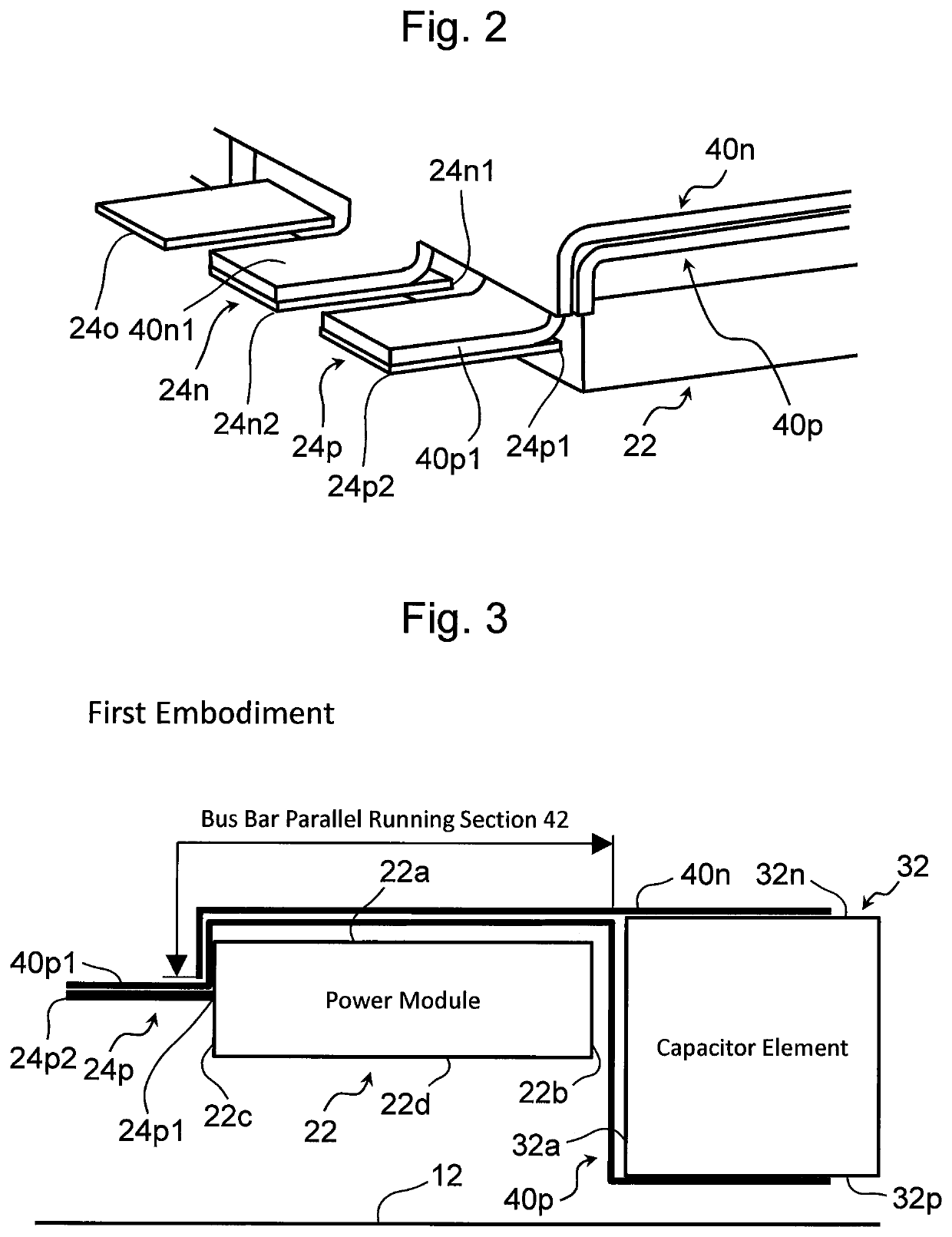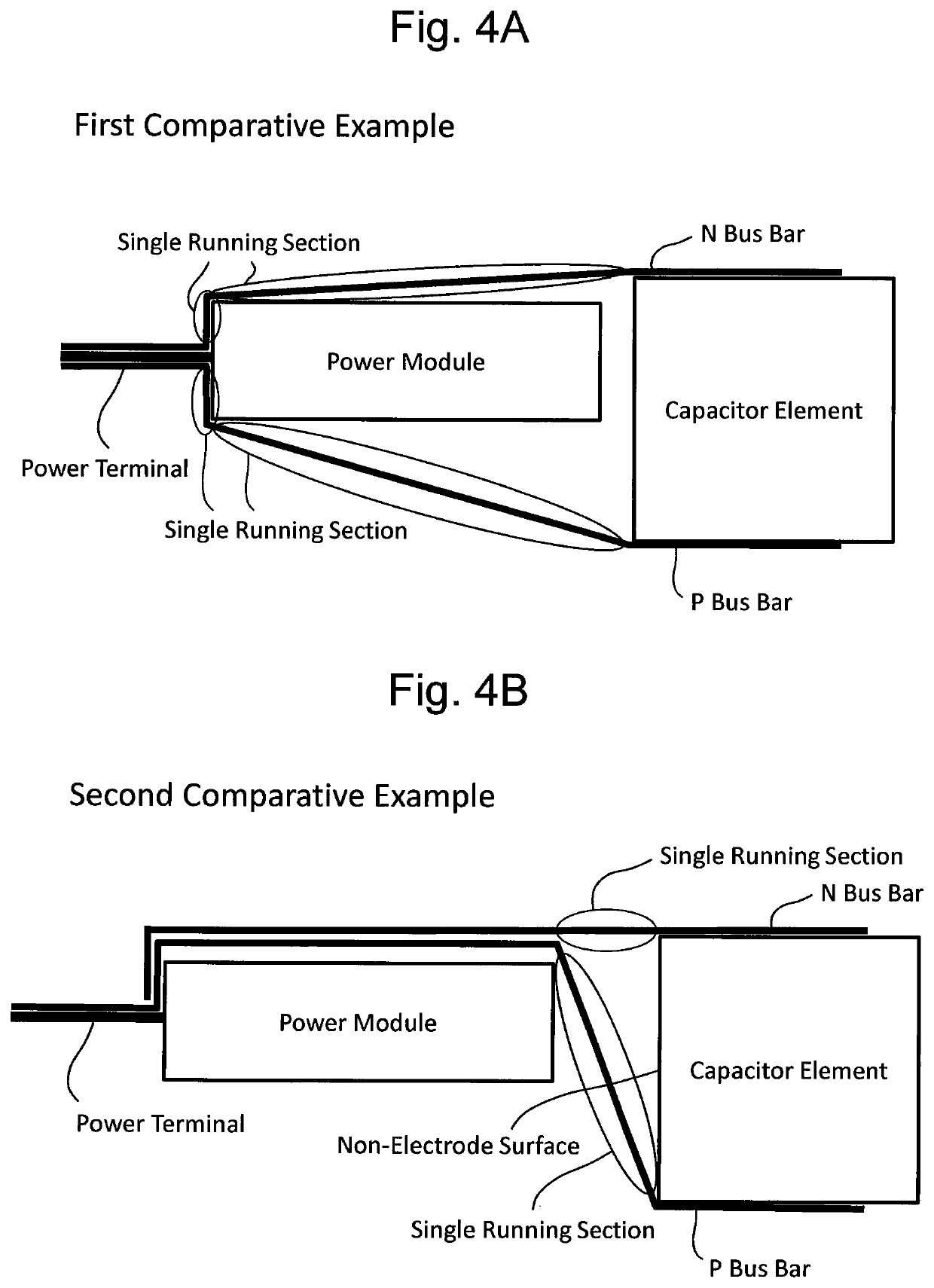Power converter
a power converter and converter technology, applied in the field of power converters, can solve the problems of reducing the degree of freedom and limited distance, and achieve the effects of reducing the loop inductance, and shortening the single run section
- Summary
- Abstract
- Description
- Claims
- Application Information
AI Technical Summary
Benefits of technology
Problems solved by technology
Method used
Image
Examples
first embodiment
1. First Embodiment
[0035]A first embodiment according to the present disclosure and modification examples thereof will be described with reference to FIGS. 1 to 6.
1-1. Configuration of Power Converter
[0036]FIG. 1 is a perspective view showing a configuration of a main part of a power converter 10 according to the first embodiment. FIG. 2 is an enlarged view of a site A around power terminals 24p, 24n and 24o in FIG. 1. As an example, the power converter 10 is mounted on an electrified vehicle provided with a drive source including a motor generator (not shown).
[0037]The power converter 10 is provide with a power semiconductor unit 20, a capacitor unit 30, a positive electrode bus bar (also referred to as a “P bus bar”) 40p and a negative electrode bus bar (also referred to as a “N bus bar”) 40n. The P bus bar 40p and the N bus bar 40n each connects the power semiconductor unit 20 with the capacitor unit 30. These bus bars 40p and 40n are made of, for example, a conductive metal.
[003...
second embodiment
2. Second Embodiment
[0070]Then, a second embodiment according to the present disclosure will be described with reference to FIG. 7. FIG. 7 is a schematic diagram showing a feature of a power converter 50 according to the second embodiment. This power converter 50 is different from the power converter 10 according to the first embodiment in the following point.
[0071]Specifically, FIG. 7 shows a P bus bar 52p and an N bus bar 40n in the bus bar parallel running section 42. In the bus bar parallel running section 42 according to the present embodiment, the P bus bar 52p is in contact (more specifically, is in close contact) with the N bus bar 40n via an insulator 54. An example of the insulator 54 is electrically insulating paper. The insulator 54 corresponds to an example of the “first insulator” according to the present disclosure.
[0072]According to the configuration of the second embodiment described above, by minimizing the distance (clearance) between the P bus bar 52p and the N b...
third embodiment
3. Third Embodiment
[0073]Then, a third embodiment according to the present disclosure will be described with reference to FIG. 8. FIG. 8 is a schematic diagram showing a feature of a power converter 60 according to the third embodiment. The power converter 60 is different from the power converter 50 according to the second embodiment in the following points.
[0074]In the present embodiment, as shown in FIG. 8, a P bus bar 62p is in contact (more specifically, is in close contact) with the non-electrode surface 32a of the capacitor element 32 via an insulator 64. An example of the insulator 64 is also an electrically insulating paper. The insulator 64 corresponds to an example of the “second insulator” according to the present disclosure.
[0075]According to the configuration of the third embodiment described above, by minimizing the distance (clearance) between the P bus bar 62p and the non-electrode surface 32a, the effect of canceling out the magnetic flux due to the fact that the el...
PUM
 Login to View More
Login to View More Abstract
Description
Claims
Application Information
 Login to View More
Login to View More - R&D
- Intellectual Property
- Life Sciences
- Materials
- Tech Scout
- Unparalleled Data Quality
- Higher Quality Content
- 60% Fewer Hallucinations
Browse by: Latest US Patents, China's latest patents, Technical Efficacy Thesaurus, Application Domain, Technology Topic, Popular Technical Reports.
© 2025 PatSnap. All rights reserved.Legal|Privacy policy|Modern Slavery Act Transparency Statement|Sitemap|About US| Contact US: help@patsnap.com



